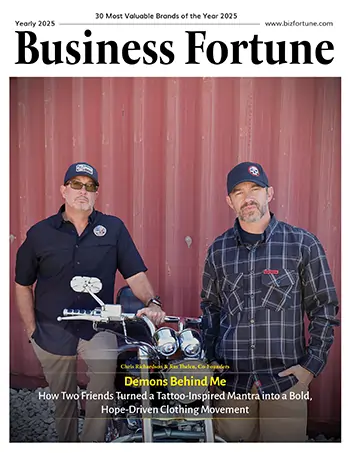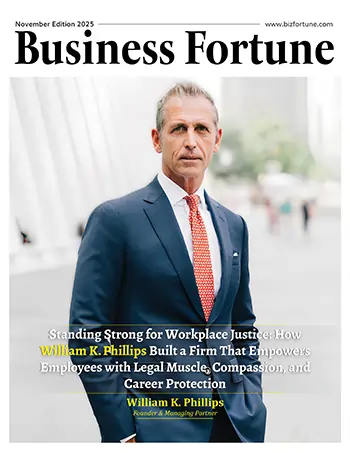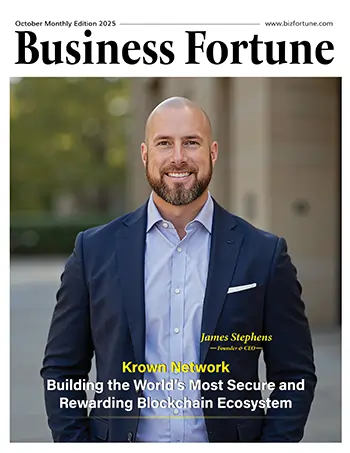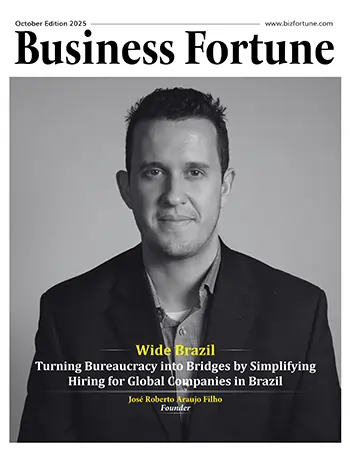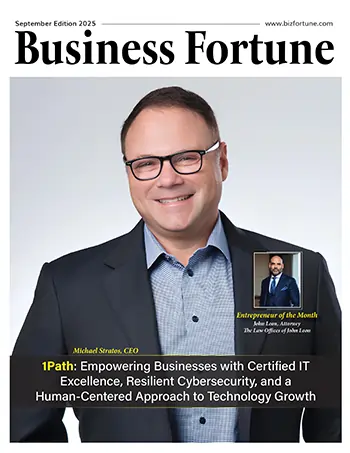Home Innovation IoT From Sketch to Skyline: How Pa...
From Sketch to Skyline: How Paula Diaz Transforms Environmentally Friendly Urban Visions into Reality
IoT
Business Fortune
11 November, 2025
by Clara Hill
The future of our cities depends on architects who prioritize sustainability and thoughtful design. Designing with green spaces, sustainable materials, and renewable energy is the foundation of resilient, livable communities.
Few embody this vision as clearly as Paula Díaz, a Bogotá-born architect and planning designer. Her passion for the field traces back to her earliest days in architecture school: “From my very first architecture class, I fell in love with it. I connected deeply with the program and the theory behind it; it simply just clicked. From then on, I knew architecture and urban design were my true calling.”
That spark quickly grew beyond the classroom. What started as a passion soon shaped her academic path. It led her to earn a double degree in Architecture and Industrial Design at Fundación Universidad de Bogotá Jorge Tadeo Lozano. However, this highly-regarded planning designer recalls her passion with design and architecture began much earlier: “I’ve always been curious about how things are made. As a kid, I loved objects and building things, and that curiosity eventually grew into a career.”
While her foundation in Bogotá provided a strong design core, moving to the United States broadened Paula’s perspective. She studied Graphic & Interactive Design at Valencia College and earned multiple technical certificates in graphic design production, interactive design, and business management. Thanks to this multidisciplinary path, Paula possesses the ability to design spaces that combine aesthetics, efficiency, sustainability, and a people-centeredness which has set her apart from her peers.
From Foundations to Innovation: Paula’s Early Career Journey
Paula’s career began with formative roles that deepened her expertise. At Concrecentro, this sought-after designer collaborated closely with the main architectural manager on residential and school building projects, assuming both design and managerial responsibilities.
At Arista Arquitectura Corporativa, Paula contributed to the design of mixed-use, commercial, and residential projects. Here she was able to instigate systems and approaches which were game changers to the process, revolutionizing the firm's approach.
She later joined PLACE Alliance as a graphic design intern, and then as an independent consultant, supporting the principals in creating architectural presentations, marketing materials, and visual concepts. Together, these early experiences gave her both breadth and depth—but they also sparked a realization: design is not only about form and function, but about long-term environmental impact.
This awareness guided Paula toward environmental architecture. Over the years, Paula has become known as an innovative architect and planning designer capable of managing projects from concept to completion. Her unique blend of sustainability and functionality has been adopted across her field. And as Paula’s freelance work expanded her portfolio, it allowed her to further experiment with integrating urban planning, site analysis, environmental strategies, and problem-solving methodologies. These cutting-edge approaches had a huge impact on project design and implementation.
Paula employs a pioneering approach by incorporating low-impact development and sustainable materials into large-scale, mixed-use projects, which reflects the impact of environmental architecture on modern urban planning. Projects like ARCA in Orlando, which feature green corridors, solar integration, and sustainable stormwater management systems, showcase her ability to set new standards for eco-conscious design. It also set a benchmark for other designers.
Paula is known for seamlessly integrating solar energy, rainwater harvesting, permeable pavements, and native landscaping into her work. For her, each challenge is an opportunity: “Every project comes with its problems to solve, and I love being part of that solution. Taking a client’s hints and ideas and turning them into something real, that’s one of the most exciting challenges for me.”
Her technical mastery—especially in 3D modeling, rendering, and digital imagery—helps her translate complex strategies into visuals that clients and communities can easily understand. Yet despite her command of technology, she always grounds herself in the timeless tool that started it all, pencil sketching. As she puts it: “I still love starting with a simple pencil sketch. There’s something about that first line on paper that sparks everything else.”
Paula brings together artistry, technical expertise, and a strong commitment to sustainability. Her versatility allows her to work across scales—from 2,000-acre master plans to intimate 5-acre communities: “Whether it’s a house, a park, or a neighborhood, I try to make sure the space feels meaningful and useful for the people who will interact with it every day. At the end of the day, the client pays for the project, but it’s the community and the city that live with it.”
That philosophy came to life in one of her most notable contributions: Sweetbay in Panama City, Florida. What began as sketches more than a decade ago has grown into a living example of sustainable urbanism: energy-efficient homes, walkable streets, and green spaces designed to foster connection.
This sought-after expert has followed the project closely over the years: “I’ve been involved with Sweetbay for years, and just recently I saw photos of a new building getting finished. It’s incredible to know that something I once sketched is now a place where families live, kids play, and people connect. That’s what makes it worth it.”
Paula helped translate concepts into tangible features—solar-powered homes, playgrounds made from recycled materials, and green corridors that support biodiversity. The Sweetbay project shows how her approach can reshape local planning.
Such inspired developers and city planners across the region have adopted more sustainable, people-centered urban models. Likewise, her work on the Ocala Greenways project introduced wildlife corridors and eco-friendly street crossings, proving that urban growth and environmental conservation can coexist—a model now often cited by other regional planners.
A Global Perspective on Building Better Communities
Back in Colombia, Paula also left a strong impression while working with Medina Prefabricados, Construcción Arquitectura y Diseño S.A.S. Legal representative Judas Germán Medina Muñoz remembers how quickly she stood out on his team: “Paula had this rare mix of creativity and professionalism that made her impossible to overlook,” he shares.
“She picked up the complexities of prefabricated construction faster than anyone I’ve seen—and more than that, she showed us how it could reduce waste, cut costs, and make our projects more sustainable. She didn’t just adapt to the work; she elevated it. What I admired most was her vision and integrity. Those qualities stayed with her, and you can still see them in the way she works today.”
Paula’s work left a lasting mark on urban planning, proving that sustainable design, community involvement, and technical precision can successfully work together. This influence has shaped how today’s architects and planners approach complex projects. A clear example is her Lake Nona master plan, which blends mixed-use development, renewable energy, and inclusive housing. It is often referenced as a model for how urban design can meet both environmental and social needs.
Marc Newman, Principal at PLACE Alliance, has worked with Paula for more than a decade and describes her as “one of the finest urban designers I’ve had the opportunity to work with.”
He commends not only her ability to tackle complex challenges across a wide range of projects— from downtown revitalization and suburban retrofits to large-scale community redevelopments and sustainable neighborhoods— but also her rare gift for collaboration. He recalls: “Paula combines sharp technical knowledge with a deep sense of place-making. She knows how to turn a team’s vision into reality while keeping the focus on how people actually live and interact within those spaces.”
Paula’s global perspective, shaped by living and working in both Colombia and the United States, does more than broaden her skillset. It sharpens her awareness of equity and access, pushing her to design solutions that work across cultures, climates, and communities. Bilingual in Spanish and English, she builds trust through collaboration and a deep respect for cultural nuances. Her involvement in organizations such as the Congress for the New Urbanism, American Planning Association, and Sociedad Colombiana de Arquitectos keeps her connected to global conversations on sustainable design.
Designing for All: Where Passion Meets Sustainability
Paula’s philosophy goes beyond sustainability; she also focuses on access and inclusion. One of her long-term goals is to make eco-friendly housing more attainable: “Affordable housing is one of the struggles I want to keep addressing. I want to be part of the solution by finding ways to create smart, inclusive housing that works for real people, not just those with higher incomes.”
Beyond her professional projects, Paula extends her people-first approach to mentoring young designers—guiding them in tools like AutoCAD, Revit, and Lumion, and encouraging innovative thinking.
As she explains: “Teaching and sharing knowledge has become a part of my work. When you collaborate with a team, you pass on tools and techniques, just like others once shared with me.”
Her dedication is fueled by love for her craft and the difference it can make. As she puts it: “I love what I do. What motivates me is knowing that my design decisions can directly improve someone’s life. Even small changes in design can build a better world.”
In Paula’s hands, a sketch turns into more than a plan; it becomes a vision for a greener, more connected tomorrow. Her innovative approach reshaped design standards and inspired architects worldwide, proving that purpose-driven design can enhance both community well-being and environmental sustainability.
Her work proves that when passion is driven by purpose, cities can grow stronger, communities can flourish, and the environment can thrive. Beyond designing spaces, this sought-after expert creates opportunities for people to live better, inspiring us all to imagine what’s possible when we design with heart.




























